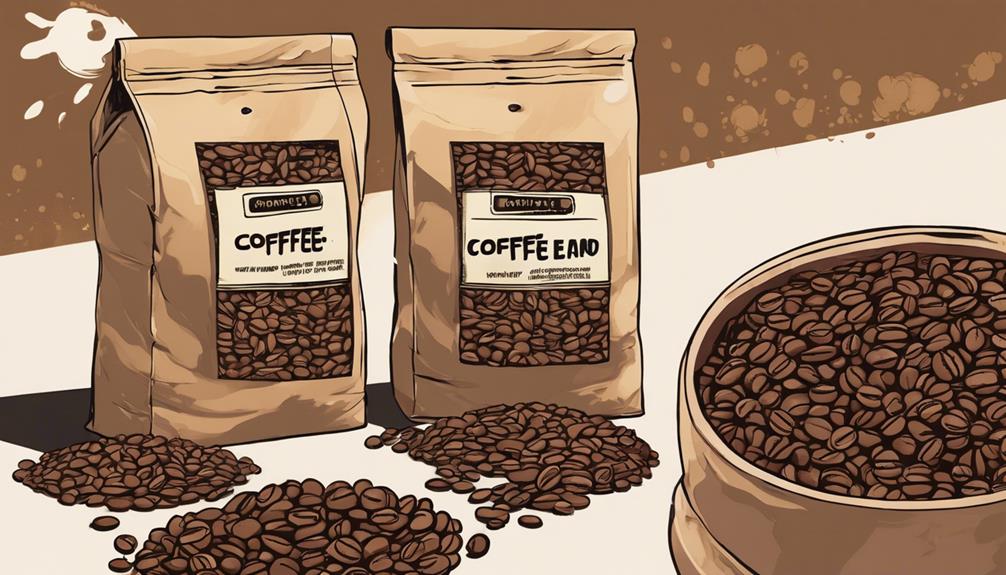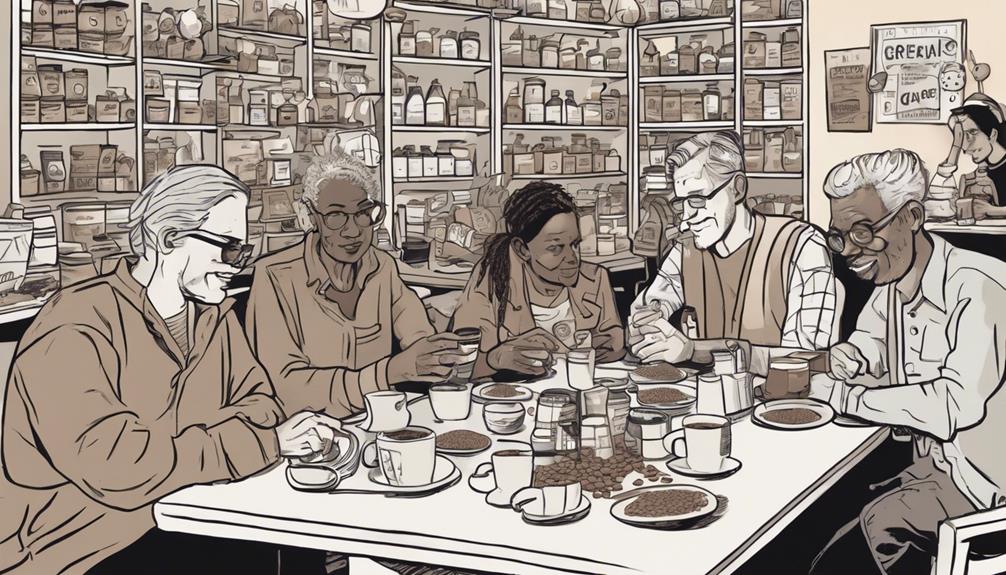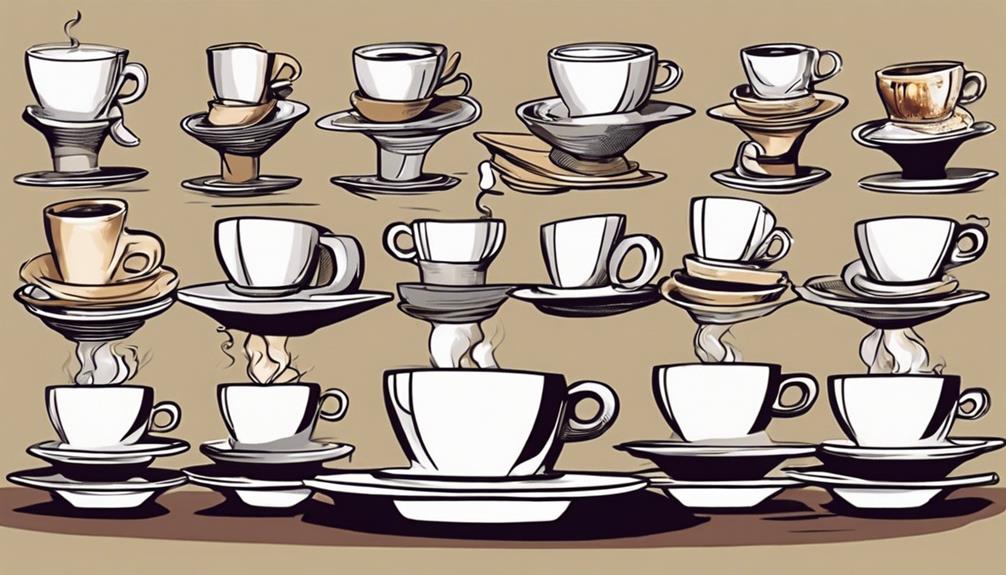Enhance your coffee beans by properly aging them. Manage storage conditions such as temperature and light exposure to enhance flavor. Opt for darker roasts and longer roasting times for a more intense taste. Explore various brewing methods to bring out distinctive flavors. Consider using airtight containers or vacuum-sealed bags for storage to keep the beans fresh. Grind the beans right before brewing to maintain optimal flavor. By aging your coffee beans correctly, you unlock a realm of intricate and bold flavors that will take your coffee experience to a whole new level.
Key Takeaways
- Opt for darker roasts to enhance flavor depth and richness.
- Store aged beans in airtight containers with gel-silica packs.
- Experiment with different brewing methods for unique flavors.
- Use cooler water temperatures to avoid harsh flavors.
- Monitor extraction time closely for optimal taste.
Factors Influencing Coffee Aging
Factors that influence the aging of coffee beans include variations in storage conditions, roasting techniques, and brewing methods. The aging process of coffee beans is a delicate dance between time and environmental factors.
When coffee beans age, changes occur in their flavor profile, including intensity, bitterness, acidity, aroma, and potential staleness. The aging process can be influenced by how the beans are stored, the techniques used during roasting, and the methods employed for brewing.
Storage conditions play a critical role in the aging process of coffee beans. Factors such as temperature, humidity, and exposure to light can impact how beans age over time.
Roasting techniques, such as darker roasts, longer roasting times, and small batch roasting, can also affect the aging process by enhancing certain flavor characteristics in the beans.
Additionally, different brewing methods like immersion, pour-over, cold brew, and espresso can bring out unique flavors in aged coffee beans.
Adjusting Brewing Techniques for Aging Beans

To optimize the flavor of aged coffee beans, consider adjusting your brewing techniques to enhance the taste profile. As coffee beans age, they can lose some of their vibrancy and develop potential bitterness. One way to counteract this is by adjusting the grind size of your coffee beans. Experiment with different grind sizes to find the one that best suits your aged beans and helps extract the desired flavors.
Additionally, tweaking the coffee-to-water ratio can make a significant difference in bringing out the unique taste of aged beans. Using slightly cooler water temperatures when brewing can also prevent over-extraction, which can lead to a harsh flavor in aged coffee. Monitoring extraction time closely and making adjustments as needed is essential for getting the most out of your aged beans.
Lastly, don't be afraid to explore different brewing methods like immersion, pour-over, cold brew, or espresso. Each method can highlight different aspects of the aging process, allowing you to discover new and exciting flavors in your aged coffee beans.
Roast Profile Considerations for Aged Beans

When aging coffee beans, you should consider opting for a darker roast to enhance depth and richness in flavor.
Roasting beans slightly longer can bring out more complex flavors in aged coffee, while avoiding light roasts that might highlight defects.
Experiment with medium-dark roasts to find a balance between preserving bean characteristics and adding depth to your brew.
Roast Levels for Aging
For aging coffee beans, selecting a darker roast level is essential to enhancing the depth of flavor in the aged beans. Dark roasts, achieved by roasting beans slightly longer, bring out rich flavors in aged coffee, making them ideal for the aging process.
Light roasts should be avoided when aging coffee, as they can highlight defects in the beans rather than improving their taste. If you're seeking a balanced and flavorful aged coffee profile, experimenting with medium-dark roasts could be a great option. These roasts offer a middle ground that combines the richness of dark roasts with the nuanced flavors of lighter ones.
To maintain freshness and flavor integrity in aged beans, consider roasting them in small batches. This approach allows you to control the roasting process more precisely and guarantees that each batch of aged coffee beans reaches its full flavor potential.
Flavor Enhancement Techniques
Selecting the appropriate roast profile is key to enhancing the flavors of aged coffee beans, particularly when aiming to achieve a rich and well-balanced taste experience.
When considering flavor enhancement techniques for aging coffee beans, keep the following in mind:
- Opt for a darker roast: Choosing a darker roast profile can intensify the depth and richness of flavors in aged coffee beans, providing a more robust taste.
- Roast slightly longer: Extend the roasting time slightly to develop complex flavor profiles and to balance out any lingering acidity in aged beans.
- Avoid light roasts: Light roasts may accentuate defects and lack the depth needed to complement the aging process of coffee beans effectively.
- Experiment with medium-dark roasts: Medium-dark roast profiles offer a middle ground that can bring out the best qualities in aged coffee beans, providing a well-rounded flavor profile.
Aging Process Impact
To optimize the flavor potential of aged coffee beans, consider adjusting the roast profile to enhance their nuanced characteristics. When aging a batch of beans, opting for a darker roast profile is key to revealing depth and richness in the final cup. Roasting the beans slightly longer than usual can help develop more complex flavors that complement the aging process.
It's best to steer clear of light roasts when aging beans, as they may accentuate defects and lack the body that aged coffee typically embodies. For a balanced flavor profile in aged coffee, experimenting with medium-dark roasts can be beneficial. These roasts strike a harmonious balance between preserving the bean's inherent qualities and infusing them with the desired aged notes.
Additionally, roasting beans in small batches can aid in maintaining freshness and ensuring that the aging potential is fully optimized. By adjusting the roast profile thoughtfully, you can elevate the flavors of your aged coffee beans to new heights.
Storage Strategies for Aging Coffee

When aging coffee beans, understanding proper aging techniques and effective storage methods is crucial.
Freezing beans in airtight containers or using vacuum-sealed bags can help preserve freshness and slow down aging effects.
Gel-silica packs are also beneficial for maintaining flavor integrity by absorbing moisture and shielding aged coffee from oxygen exposure.
Proper Aging Techniques
Properly storing aged coffee is essential to preserving its flavor and extending its lifespan. To safeguard your aged coffee beans maintain their quality, consider the following storage techniques:
- Utilize Airtight Mason Jars: Transfer your aged coffee beans into clean, hermetically sealed mason jars to shield them from moisture and oxygen, which can degrade the flavor.
- Freeze for Freshness: If you have a surplus of aged coffee beans, freezing them can help retain their freshness and slow down the aging process.
- Extend Lifespan with Sealing: Use vacuum sealing or gel-silica packs when storing aged coffee to prolong its lifespan and preserve its rich flavor profile.
- Divide into Portions: Splitting your aged coffee into smaller portions for storage can help maintain the beans' flavor integrity over time.
Effective Storage Methods
For best preservation of aging coffee beans, consider employing vacuum sealing to maintain freshness and slow down the aging process. Vacuum sealing helps create an airtight environment that prevents oxygen exposure, a key factor in preserving the flavors of aged coffee.
Moisture poses a threat to the quality of aged coffee, so storing beans in a dry location is essential. Additionally, freezing aged coffee beans in airtight containers can greatly extend their shelf life while keeping their flavors intact.
To combat moisture, using gel-silica packs in storage containers can effectively absorb excess humidity and prevent flavor degradation in aged coffee. When storing larger batches of aged coffee for extended periods, vacuum sealing can be particularly advantageous in maintaining freshness over time.
Impact of Grinding on Coffee Shelf Life

How does grinding coffee beans affect their shelf life and flavor retention?
When you grind coffee beans, you impact how long they'll stay fresh and flavorful. Here are some key points to keep in mind:
- Increased Surface Area: Grinding coffee beans creates more surface area, exposing the grounds to oxygen and causing them to lose freshness faster.
- Loss of Freshness: Once coffee beans are ground, their shelf life decreases significantly, leading to a quicker deterioration in flavor.
- Quality Deterioration: Grinding finer to extract the last 1% of coffee mightn't be worth it due to the accelerated degradation in quality.
- Freshness Maintenance: To enjoy the freshest taste, it's advisable to grind your beans daily to prevent quick staling.
Expert Recommendations on Coffee Quality

When considering expert recommendations on coffee quality, prioritizing freshness emerges as a key factor for enhancing the overall taste experience. The quality of your coffee beans greatly impacts the flavor profile of your brew. Here are some expert recommendations to ensure high-quality coffee:
| Recommendation | Description |
|---|---|
| Purchase Fresh Beans | Opt for recently roasted beans to maximize flavor potential. |
| Store Properly | Keep beans in an airtight container away from light, heat, and moisture to maintain freshness. |
| Grind Just Before Brewing | Grind your beans just before brewing to preserve the volatile aromas and flavors. |
| Consider Bean Origin | Explore different bean origins to discover unique flavor profiles that suit your preferences. |
| Experiment with Roast Levels | Try various roast levels to find the perfect balance of acidity, body, and aroma in your cup. |
Community Insights and Brewing Tips

Community insights into aging coffee beans often highlight the importance of adapting brewing techniques to optimize the flavor extraction process. When delving into the world of aged coffee beans, enthusiasts recommend fine-tuning your brewing methods to make the most of these unique beans. Maximizing grass growth with coffee grounds can also be a beneficial way to repurpose aged coffee beans. Some coffee enthusiasts have found success in using old coffee grounds as a natural fertilizer for their lawns and gardens, helping to promote healthy plant growth while also reducing waste. By exploring various ways to utilize aged coffee beans beyond brewing, enthusiasts can truly appreciate the full potential of these special coffee beans.
Here are some valuable brewing tips to keep in mind:
- Experiment with Bloom Times: Try extending the bloom time to allow the coffee grounds to degas adequately, enhancing the overall flavor profile.
- Adjust Grind Sizes: Test different grind sizes to find the perfect balance that suits the aged coffee beans, ensuring a consistent and flavorful extraction.
- Take into Account Origin and Density: Consider the origin and density of the beans when adjusting your brewing techniques, as these factors can greatly impact the final taste.
- Share and Learn: Engage with the coffee community to exchange experiences and insights, gaining valuable knowledge to refine your brewing skills and elevate your coffee-drinking experience.
Frequently Asked Questions
How Do You Intensify Coffee Flavor?
To intensify coffee flavor, you can experiment with aging techniques. Explore storage methods that enhance richness and complexity. By aging beans properly, you reveal a smoother taste with deep nuances, transforming your coffee experience into a gourmet delight.
What Can I Add to Coffee to Make It Taste Better?
To make your coffee taste better, try adding a pinch of salt for enhanced flavor, a sprinkle of cinnamon or nutmeg for an aromatic twist, a splash of vanilla extract for sweetness, or a teaspoon of cocoa powder for a chocolatey note.
How Do You Make Coffee Beans Taste Better?
Want to make coffee beans taste better? Start by experimenting with different roast levels. Lighter roasts highlight origin flavors, while darker roasts bring out rich, bold notes. Find your perfect roast to elevate your coffee experience!
Do Coffee Beans Get Better With Age?
Do coffee beans get better with age? Aging coffee beans can reduce acidity, enhance body, and bring out complex flavors. The process originated during sea voyages, creating unique taste profiles. Monsooned Malabar coffee from India offers a remarkably smooth taste.
Conclusion
To sum up, by aging your coffee beans properly, adjusting your brewing techniques, considering roast profiles, storing your beans correctly, and grinding them with care, you can enhance the flavor and quality of your coffee.
Remember, the key to a great cup of coffee lies in the details. So go ahead, experiment, and enjoy the delicious results of your efforts.
Happy brewing!









